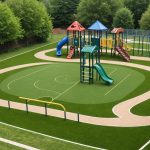Introduction to Plyometric Workouts for Basketball Guards
Plyometric workouts are a crucial element in enhancing basketball skills, especially for guards aiming to improve their explosive performance. These workouts focus on developing quick, powerful movements that are pivotal in basketball. By incorporating plyometric exercises, guards can enhance their agility, speed, and reaction time, essential components for excelling in their position.
Basketball requires a blend of athleticism and precision, where explosiveness can make a significant difference. Plyometrics come into play by stimulating fast-twitch muscle fibres, crucial for movements like quick direction changes and high jumps. Guards benefit from an increase in vertical lift and improved lateral quickness, both vital for effective gameplay.
Also to read : Conquering Pre-Game Anxiety: Key Strategies for UK Basketball Players to Excel
These exercises are designed to translate power from strength training into actual game performance. They’re not solely about building muscle but about fostering a seamless transition of energy that enhances on-court abilities. Plyometrics, therefore, provide guards with an edge, allowing them to navigate the court with more agility and react swiftly to opponents. By focusing specifically on these tailored workouts, basketball guards can amplify their overall explosive performance, ultimately improving their gameplay.
Essential Plyometric Exercises for Guards
Incorporating targeted plyometric exercises into a guard’s training routine can drastically enhance both explosive performance and agility.
Have you seen this : Mastering Free-Throw Accuracy: Effective Visualization Strategies for UK Basketball Players
Box Jumps
Box jumps are a foundational plyometric exercise focusing on power and explosive strength. Guards can benefit significantly from these jumps, as they replicate on-court movements like quick leaps and defensive maneuvers. Begin with a box of appropriate height and aim for three sets of 10 repetitions to reduce fatigue while maximizing performance.
Depth Jumps
Depth jumps involve stepping off a raised platform, landing softly, and immediately jumping upward. This exercise is crucial for guards, particularly for increasing vertical leap and improving reaction times. It’s advisable to start with moderate height and gradually increase as skill develops. A recommended progression might involve beginning with two sets of five repetitions and increasing to three sets as performance improves.
Single-Leg Hops
Focusing on one leg at a time, single-leg hops assist in balancing strength and coordination, critical for agility and court movement. Guards should maintain balance and control by performing hops over a short distance, gradually increasing both distance and intensity. Consider alternating legs, with repetitions fitting within three sets of eight per leg to enhance stability and explosive power.
Designing a Plyometric Training Routine
Creating a well-rounded training routine is crucial for guards looking to maximize explosiveness and agility through plyometrics. First, a balanced weekly schedule should be established. Incorporating plyometric workouts two to three times per week, interspersed with strength training sessions, ensures comprehensive development and minimises overuse injuries.
Integrating rest and recovery days is pivotal. Plyometric exercises put significant strain on muscles and joints, so adequate recovery is essential to prevent fatigue and aid muscle repair. A good practice is to allow at least 48 hours between intense plyometric sessions.
Tailor each session to include a warm-up, the main workouts, and a cool-down. Begin with light agility drills or dynamic stretches to prep the body. Conclude with static stretching to enhance flexibility and reduce soreness.
Lastly, adjust the intensity based on progress and maintain a flexible approach. Focus on how the body responds, avoiding overexertion while still pushing towards goals. Regularly re-evaluate the routine, adjusting for increased strength or stamina as needed. This personalised approach keeps the routine effective and engaging, ensuring ongoing progress in explosive performance.
Techniques for Effective Plyometric Training
Implementing training techniques with precision is crucial for successful plyometric workouts. One of the core aspects is maintaining proper form; this ensures maximum efficiency and safety during exercises. Athletes should focus on landing softly and ensuring a stable core posture, reducing the impact on joints and preventing injuries.
Common mistakes to watch out for include improper alignment and inadequate control during explosive moves. These can lead to strain and undermine workout effectiveness. Guards should aim to keep their knees aligned with toes during landings to prevent undue stress.
Injury prevention is paramount in any training routine. Warming up properly and incorporating dynamic stretches can prepare muscles and minimize injury risks. Cooling down with static stretching further aids in muscle recovery.
A sound practice is gradually increasing intensity and not rushing through exercises. Overexertion can lead to fatigue and potential setbacks. Listening to one’s body and pacing appropriately ensures long-term progress without compromising physical health. Training in a safe environment with adequate space and optimal surfaces supports these practices, allowing guards to train effectively and safely, enhancing their overall explosive performance.
Measuring Progress and Adaptation
Tracking improvements in plyometric performance is essential for basketball guards aiming to enhance their explosiveness and agility. Regular fitness assessments help monitor developments and pinpoint areas needing improvement. Techniques such as timed sprints or jump height measurements can offer valuable insights into training adaptation.
Incorporating performance metrics and feedback loops in your routine increases accuracy. This may involve keeping a log of exercise stats, like jump counts or distances covered. Comparing these numbers over time reveals progress trends and helps tailor workouts to bolster strengths or address weaknesses.
For a comprehensive analysis, consider using video for technique evaluation. Filming exercises provides tangible evidence of performance, allowing for precise critique of movements and form. It highlights subtle changes that might go unnoticed, aiding training adaptation by identifying inefficiencies.
Adjusting workouts over time is key to continued growth. Gradually increase exercise intensity or introduce new drills to challenge the body, preventing stagnation. Listening attentively to physical and cognitive cues ensures you push limits safely. Observing how your body reacts enables a dynamic routine, shifting exercises as needed for optimal results in explosiveness and agility.
UK Resources for Basketball Training
Accessing high-quality basketball training facilities is essential for athletes looking to elevate their game in the UK. With multiple centres dedicated to fostering athletic talent, players can find venues that cater to their specific training needs. Key locations like the National Basketball Performance Centre in Manchester provide comprehensive environments for skill enhancement.
For those seeking expert guidance in plyometric training, several noteworthy coaching resources are available. Prominent coaches often affiliated with basketball academies offer tailored sessions to improve explosive performance and agility. Engaging with such experts ensures a well-rounded approach to refinement and skill development.
When in-person sessions aren’t feasible, athletes can turn to various online resources. Platforms like Basketball England offer a wealth of guidance through video tutorials and training plans designed by professional coaches. These resources are invaluable for understanding the nuances of plyometrics and integrating them effectively into your routine.
Exploring these UK-specific resources enhances access to knowledge and skills integral to basketball success. Utilizing local options and digital content provides guards—and all players—with the necessary tools to improve their gameplay and maintain high performance levels.






